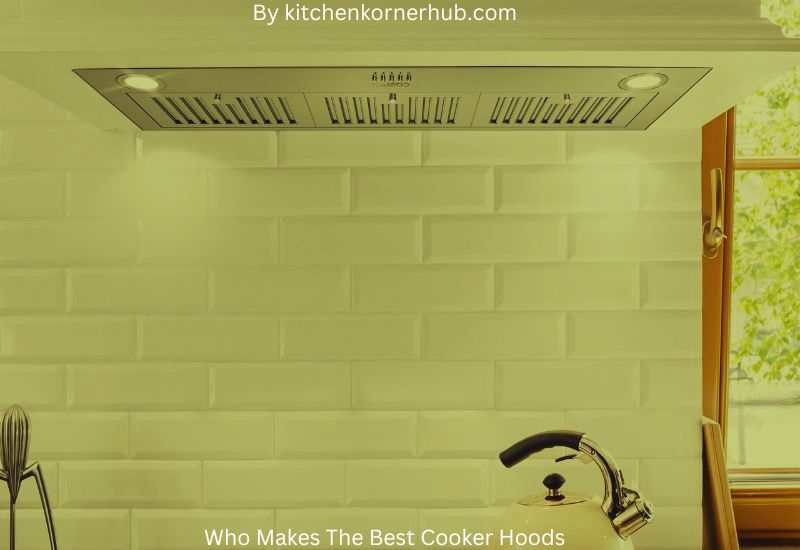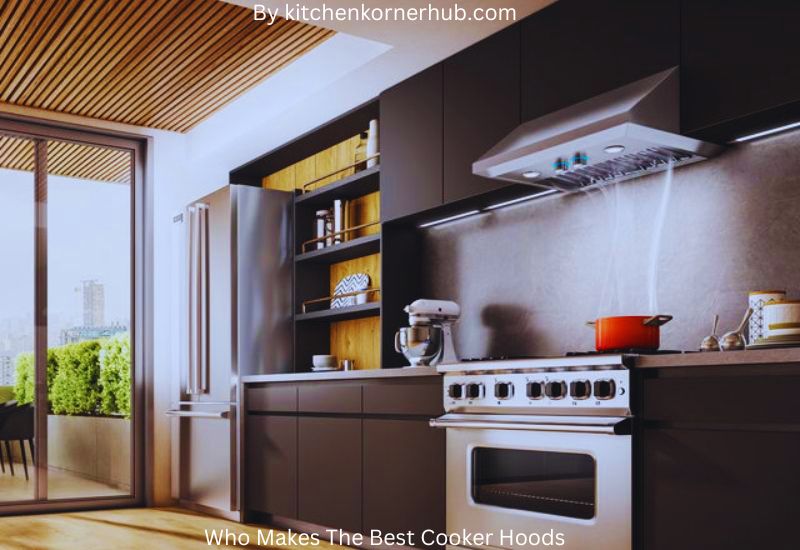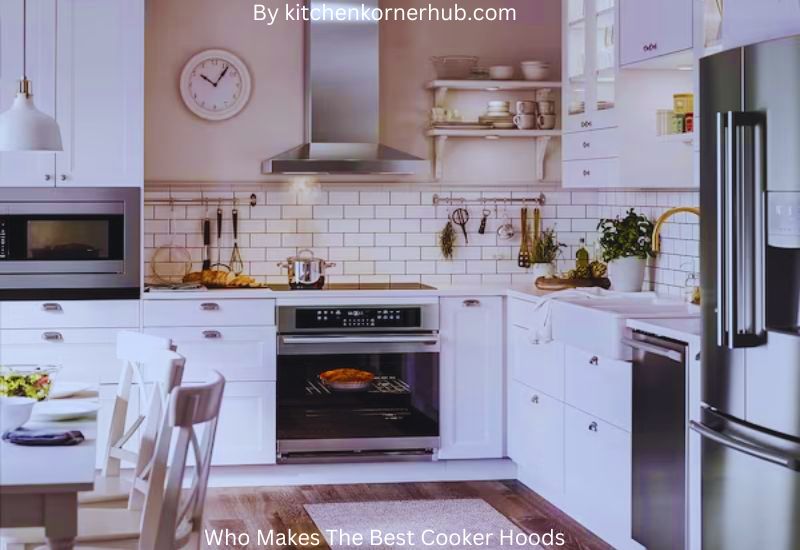When it comes to creating a comfortable and inviting kitchen environment, a crucial yet often overlooked appliance is the cooker hood. These handy devices play a vital role in keeping your kitchen fresh and free from the lingering aromas and steam that cooking can produce. With numerous brands and models available in the market, the question arises: Who makes the best cooker hoods? To find the answer, one must consider factors like performance, noise level, design, and energy efficiency. In this exploration, we will delve into the world of cooker hoods, examining popular brands and their standout features. By understanding the options available, you can make an informed choice that best suits your cooking habits and kitchen layout.
Who Makes The Best Cooker Hoods? Determining the absolute best cooker hood brand can be subjective as preferences vary. However, some highly regarded options include Bosch, Broan, and Zephyr. It’s advisable to consider factors like performance, design, and customer reviews when choosing a cooker hood that suits your needs.
Cooker hoods are essential for maintaining a pleasant kitchen atmosphere. Amid various brands and models, determining the top contenders requires assessing factors such as performance, noise, design, and energy efficiency. This review aims to uncover leading cooker hood manufacturers, facilitating an informed choice for an optimal kitchen experience.
Top Brands in Cooker Hoods

Cooker hoods, also known as range hoods or kitchen hoods, have become an essential appliance in modern kitchens, effectively removing smoke, odors, and grease particles from the air. Several top brands have established themselves as leaders in the cooker hood industry, offering innovative designs, advanced technologies, and efficient performance to cater to the diverse needs of consumers.
Bosch:
Bosch, a renowned name in home appliances, has garnered a reputation for producing high-quality cooker hoods. Known for their sleek and contemporary designs, Bosch cooker hoods seamlessly blend with various kitchen aesthetics. The brand emphasizes energy efficiency and offers a range of models equipped with powerful extraction systems that effectively eliminate cooking fumes and odors. Their hoods often feature intuitive controls, multiple fan speed settings, and even sensor-based automatic operation, ensuring a clean and fresh kitchen environment.
Zephyr:
Zephyr is synonymous with luxury and innovation in the world of cooker hoods. Famed for their avant-garde designs, Zephyr cooker hoods not only excel in functionality but also serve as striking focal points in modern kitchens. The brand offers a diverse range of options, including wall-mounted, island, and under-cabinet hoods, allowing homeowners to choose the perfect fit for their kitchen layout. Zephyr is known for incorporating cutting-edge ventilation technology that ensures quiet operation, efficient air purification, and customizable lighting options.
Miele:
Miele, a brand synonymous with premium household appliances, delivers exceptional quality and performance in its cooker hoods. Miele cooker hoods are celebrated for their meticulous craftsmanship, durability, and advanced features. The brand often integrates innovative filtration systems, such as removable and washable metal grease filters and optional charcoal filters for enhanced odor removal. Miele’s commitment to sustainability is reflected in its energy-efficient designs, making their cooker hoods both eco-friendly and highly functional.
Whirlpool:
Whirlpool has a strong presence in the cooker hood market, offering a wide array of models that cater to different kitchen setups and personal preferences. The brand’s cooker hoods are known for their reliability and efficient extraction capabilities. Whirlpool emphasizes user convenience by incorporating features like intuitive touch controls, adjustable fan speeds, and automatic shut-off timers. Their hoods often come with powerful LED lighting, enhancing visibility over the cooking area while adding an aesthetic touch to the kitchen.
Elica:
Elica has made a mark in the cooker hood industry by combining innovative design with powerful functionality. The brand is celebrated for its unique and stylish hood designs that transform kitchen ventilation into an artistic element. Elica incorporates advanced technologies like perimeter aspiration, which ensures efficient air capture from all sides of the hood. Additionally, Elica cooker hoods often come equipped with user-friendly controls, low noise levels, and effective filtration systems to maintain a clean and comfortable kitchen environment.
Performance and Efficiency Comparison

In today’s rapidly evolving technological landscape, businesses and individuals alike seek optimal solutions that balance performance and efficiency to achieve desired outcomes. This entails making informed decisions between options that offer varying levels of speed, capability, and resource utilization. A comprehensive comparison of performance and efficiency factors is vital for making informed choices across various domains.
Defining Performance and Efficiency
Performance refers to the speed and capability of a system, process, or entity in delivering results. It often translates to higher processing power, faster execution times, and better output quality. On the other hand, efficiency pertains to achieving desired outcomes with minimal waste of resources, such as time, energy, or cost. Striking the right balance between these two attributes is crucial for optimizing workflows and systems.
Factors Influencing Performance
Several factors contribute to the performance of a system. Hardware specifications, like CPU speed, GPU capability, and memory capacity, significantly impact the speed of execution for tasks. Software optimization, parallel processing, and algorithm efficiency also play pivotal roles in enhancing performance. For instance, in the realm of software development, choosing the right data structures and algorithms can dramatically impact execution speed.
Factors Influencing Efficiency
Efficiency is primarily influenced by resource allocation and utilization. Energy-efficient hardware components reduce power consumption, leading to longer battery life in mobile devices and reduced electricity costs for data centers. Resource allocation algorithms, such as load balancing in distributed systems, ensure that tasks are distributed evenly, preventing resource wastage. Additionally, well-designed software interfaces and user experience (UX) designs contribute to efficiency by minimizing the time users spend searching for information or navigating through applications.
Trade-offs Between Performance and Efficiency
The relationship between performance and efficiency is often characterized by trade-offs. Achieving peak performance might require higher resource consumption, leading to reduced efficiency. Conversely, optimizing efficiency might result in sacrificing some performance capabilities. For example, overclocking a CPU can boost performance but at the cost of increased power consumption and heat generation. Balancing these trade-offs necessitates a clear understanding of the goals and priorities of the specific use case.
Domain-specific Considerations
The significance of performance and efficiency varies across domains. In fields like financial trading or scientific simulations, where milliseconds can influence outcomes, raw performance takes precedence. In contrast, applications like IoT devices or edge computing require careful resource management to ensure longevity and consistent operation. Cloud computing services strive to provide scalable performance while managing energy consumption to minimize environmental impact.
Innovative Features in Cooker Hoods

Cooker hoods, also known as range hoods or exhaust hoods, have evolved significantly over the years from simple functional devices to sophisticated kitchen appliances that not only effectively remove cooking odors and pollutants but also add a touch of style and convenience to modern kitchens. The integration of innovative features in cooker hoods has revolutionized their performance, usability, and overall user experience. Here are some noteworthy advancements in cooker hood technology:
Smart Technology Integration:
One of the most prominent trends in cooker hoods is the integration of smart technology. Many modern cooker hoods come equipped with sensors and connectivity features that enable them to automatically adjust their fan speed and extraction power based on the cooking activity. These smart hoods can also be controlled remotely through smartphone apps, allowing users to monitor and control ventilation even when they are not in the kitchen. This not only enhances convenience but also contributes to energy efficiency by optimizing ventilation based on real-time conditions.
Noise Reduction Techniques:
Cooker hoods have traditionally been associated with loud noise levels due to their powerful extraction fans. However, innovative advancements have led to the incorporation of noise reduction technologies. Improved motor designs, sound-absorbing materials, and sophisticated fan blade configurations now ensure quieter operation without compromising on performance. This development is particularly valuable in open-concept kitchen designs where noise reduction contributes to a more pleasant cooking and dining environment.
Filter Longevity and Efficiency:
Efficient filtration is essential for removing grease, smoke, and other particles from the air. Innovative cooker hoods feature advanced filtration systems, often with multiple layers of filters, including mesh, activated charcoal, and even HEPA filters. These filters are designed for optimal particle capture and are also easier to clean and replace, contributing to the longevity of the appliance. Some models also incorporate filter change indicators that notify users when it’s time to replace filters, ensuring consistent performance.
Ambient Lighting and Aesthetics:
Cooker hoods have transcended their utilitarian role and are now considered design elements in modern kitchens. Many innovative models come with built-in ambient lighting features that can be customized to match the kitchen’s aesthetic. LED lighting strips not only enhance the visual appeal of the cooker hood but also provide functional lighting for the cooking area. This combination of aesthetics and utility adds to the overall ambiance of the kitchen space.
Auto-Cleaning Functionality:
Cleaning the cooker hood and its filters can be a cumbersome task. However, several innovative cooker hood models now incorporate auto-cleaning functionality. These self-cleaning systems utilize heat and steam to break down grease and residue, which is then collected in a separate container for easy disposal. This feature not only reduces the frequency of manual cleaning but also ensures that the cooker hood maintains its optimal performance over time.
Customer Reviews and Satisfaction Ratings

In the age of digitalization, customer reviews and satisfaction ratings have emerged as pivotal determinants of business success. They offer invaluable insights into the perceptions and experiences of consumers, influencing purchasing decisions and brand reputation.
The Impact on Consumer Decision-making:
Customer reviews have transformed the way consumers make purchasing choices. Potential buyers often turn to these reviews to gauge the quality, reliability, and performance of a product or service. Positive reviews can instill confidence and accelerate the decision-making process, while negative reviews can raise doubts and deter potential customers. This shift in reliance on peer feedback underscores the significance of maintaining a positive online reputation.
Influence on Brand Credibility:
Satisfaction ratings and reviews significantly contribute to building or tarnishing a brand’s credibility. A consistent stream of positive reviews portrays a brand as trustworthy and customer-centric, fostering loyalty and repeat business. On the contrary, a series of negative reviews can erode trust, making it imperative for businesses to address customer concerns promptly and transparently. By actively engaging with feedback, companies can demonstrate their commitment to customer satisfaction and improve their overall image.
The Role of Authenticity:
The authenticity of customer reviews is paramount. With the prevalence of fake reviews, businesses must ensure that the feedback they showcase is genuine and unbiased. Consumers have grown adept at spotting fabricated reviews, and their trust can be shattered if they perceive dishonesty. Many platforms employ algorithms and verification techniques to filter out fraudulent reviews, but maintaining transparency and integrity is ultimately the responsibility of the business itself.
Harnessing Reviews for Improvement:
Customer reviews serve as a direct line of communication from consumers to businesses. They highlight areas of excellence and pinpoint aspects that need improvement. This feedback loop can be a goldmine of actionable insights for product enhancement, service refinement, and overall customer experience optimization. Companies that embrace reviews as constructive feedback rather than mere critique can adapt more swiftly to evolving customer preferences and stay ahead of the competition.
Measuring and Enhancing Customer Satisfaction:
Satisfaction ratings provide businesses with quantifiable metrics to gauge customer contentment. These metrics, often presented in the form of Net Promoter Score (NPS) or Customer Satisfaction Score (CSAT), offer a snapshot of overall satisfaction levels. Regular analysis of these scores can help identify trends, areas of concern, and opportunities for growth. By using this data to tailor strategies and refine offerings, businesses can create a virtuous cycle of improved satisfaction and increased positive reviews.
Durability and Longevity of Cooker Hoods

Cooker hoods, an essential appliance in modern kitchens, play a pivotal role in maintaining air quality by extracting cooking fumes and odors. When investing in a cooker hood, one of the key considerations is its durability and longevity. Several factors contribute to the longevity of cooker hoods, ensuring they remain functional and efficient over time.
Build Quality and Materials:
The foundation of durability lies in the build quality and choice of materials. Stainless steel and tempered glass are common materials due to their resistance to heat, moisture, and corrosion. These materials not only enhance the aesthetic appeal but also contribute to the overall sturdiness of the cooker hood. A well-constructed exterior prevents damage caused by steam, grease, and accidental impacts, extending the lifespan of the appliance.
Motor and Ventilation System:
The heart of any cooker hood is its motor and ventilation system. A high-quality motor with adequate power ensures efficient extraction of fumes and particulates. It’s important to select a cooker hood with a motor capable of handling the size of your kitchen and cooking habits. Moreover, a well-designed ventilation system prevents the accumulation of grease and debris, reducing strain on the motor and enhancing its longevity.
Maintenance and Cleaning:
Regular maintenance and cleaning are essential to prolong the life of a cooker hood. Grease and grime buildup can clog filters, hinder airflow, and strain the motor. Most modern cooker hoods come with easily removable and washable filters. Regular cleaning of these filters, along with wiping down the exterior surfaces, prevents the accumulation of stubborn stains and maintains optimal functionality.
Heat and Moisture Resistance:
Cooking involves a range of temperatures and moisture levels, which can impact the durability of a cooker hood. Opt for models designed to withstand high temperatures, as well as those equipped with moisture-resistant components. This not only ensures the appliance remains operational but also prevents potential safety hazards caused by malfunctions due to extreme conditions.
Brand Reputation and Warranty:
When selecting a cooker hood, considering the brand reputation is vital. Reputable manufacturers often prioritize quality and offer longer warranties, reflecting their confidence in the durability of their products. A substantial warranty provides added assurance that the cooker hood is built to last. Researching customer reviews and ratings can provide valuable insights into real-world experiences with a specific model.
Conclusion
In the quest to determine the best cooker hood, a comprehensive evaluation of various brands and models has been conducted. While preferences may vary based on individual needs and kitchen setups, certain brands consistently emerge as frontrunners in terms of performance, design, and customer satisfaction. Through an amalgamation of technical prowess and innovative features, these industry leaders showcase their commitment to enhancing culinary experiences. Ultimately, the title of the best cooker hood remains subjective, yet the market showcases a diverse array of top-tier options, allowing consumers to make informed decisions based on their unique requirements
Frequently Asked Question(Who Makes The Best Cooker Hoods)
Which cooker hood is the best?
Determining the best cooker hood depends on several factors such as your kitchen layout, cooking habits, and budget. It’s essential to find a balance between performance, aesthetics, and features. Look for reputable brands like Bosch, Samsung, and Broan, which often offer a range of models catering to different needs.
Read reviews, consider noise levels, extraction rates, and available features like adjustable fan speeds, lighting, and filter types. Ultimately, the best cooker hood for you will align with your specific requirements and preferences.
Is Bosch cooker hood good?
Bosch cooker hoods are generally considered reliable and efficient options. Bosch, a reputable brand in the kitchen appliance industry, offers a variety of cooker hood models that combine modern design with practical functionality.
They are known for their advanced extraction technology, effective filtration systems, and user-friendly controls. Bosch cooker hoods are often designed to complement contemporary kitchen aesthetics while providing optimal ventilation during cooking.
What to look for when buying a cooker hood?
When purchasing a cooker hood, there are several key factors to consider. Firstly, assess the extraction rate, which indicates how efficiently the hood can remove cooking odors and smoke. Opt for a hood with adjustable fan speeds to cater to different cooking scenarios. Noise level is crucial, as quieter operation ensures a more comfortable cooking environment.
Look for energy-efficient models with LED lighting for better visibility. The hood’s size should match your stove dimensions, and consider whether you prefer a wall-mounted, island, or integrated hood, based on your kitchen layout.
What is the best extraction rate for a cooker hood?
The extraction rate, measured in cubic meters per hour (m³/h), determines how quickly a cooker hood can ventilate your kitchen. As a general guideline, aim for an extraction rate that is at least 10 times the volume of your kitchen space.
For example, if your kitchen is 20 square meters, look for a cooker hood with an extraction rate of at least 200 m³/h. However, if you frequently engage in heavy-duty cooking with strong odors, consider opting for a higher extraction rate to ensure efficient ventilation.




